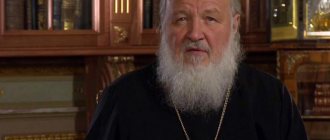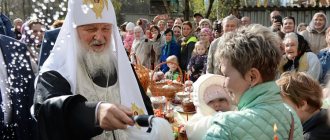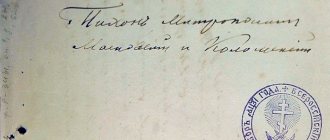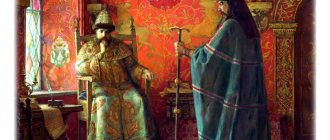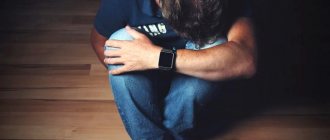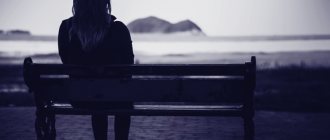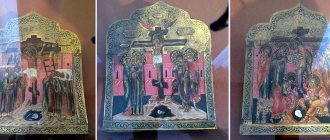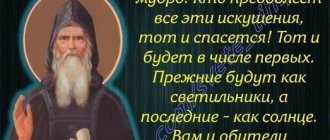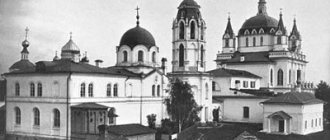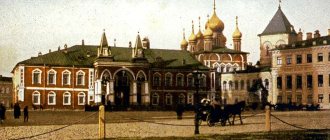Childhood
On February 23, 1929, a boy, Alyosha, was born into the family of Mikhail Alexandrovich Ridiger and Elena Iosifovna Pisareva in the capital of Estonia, Tallinn. His descendants were Russified German nobles and Estonians. The Ridiger family at one time emigrated from St. Petersburg to Estonia. Mikhail Alexandrovich was a clergyman. The family was famous for its deep faith and piety, which took deep roots in Alyosha’s soul.
Patriarch Alexy II
The family life of the Ridiger couple was inseparable from church service. At the age of 6, little Alyosha first participated in worship as an assistant; he poured holy water for parishioners during the celebration of the Epiphany.
The boy’s desire to serve in church, having learned the Liturgy by the age of 9, caused confusion among his parents, who calmed down after visiting the Valaam monks. The elders advised not to restrain the boy in his desire to serve if he takes church service seriously and with all understanding.
During family pilgrimage trips to the monasteries of Pskov-Pechersky, Holy Dormition, Holy Transfiguration on Valaam, Alyosha was granted by God a meeting with blessed monks. The elders had a special influence on the further life of the youth:
- schema-abbot Ioann (Alekseev);
- Hieroschemamonk Ephraim (Khrobostov);
- monk Iuvian (Krasnoperov).
The hermit’s saints immediately felt a kindred spirit in the youth; they happily talked with him during the family’s pilgrimage trips. Through the spring of Russian holiness, Valaam, young Ridiger learned about the Monk John of Kronstadt, who was canonized during the patriarchal service of Alexy II. Allowed to serve at the altar of the Valaam shrines, the young man decides to devote himself to God and serving people.
Death message
An hour before noon, on December 5, 2008, the head of the press service of the Moscow Patriarchate, Vladimir Vigilyansky, announced the sudden death of the patriarch. The Vladyka’s place of exodus was his own residence, not far from the village of Peredelkino. According to the staff, Alexy II went to the bathroom to wash his face at about 7 am. Closer to 8:00, the patriarch did not come out for the ordered breakfast.
Concerned employees went to check on His Holiness's chambers, but found the doors to the bedroom closed. During the inspection of the chambers through the street windows, it was discovered that the old man was most likely in the bathroom. Alexy does not respond to offers of help.
Security was immediately called, whose employees managed to break down the door. Vladyka was found lying on the bathroom floor. The body was already cooling down. The arriving doctors had no choice but to declare the patriarch’s death from a heart attack.
Church service in youth
Serving in the temple became a major part of the teenager’s life. A 15-year-old subdeacon serves the archdeacon during services. Bishop Isidore and Archbishop Paul of Estonia and Tallinn entrust the accompanying mission to Alexei Ridiger.
Upon reaching the age of 16, he is appointed as an altar boy, sacristan in the Tallinn Cathedral Church, where he serves until 1946
Upon reaching the 18th anniversary, the Leningrad Orthodox Theological Seminary and Theological Academy in Leningrad became the steps for becoming a priest. The celibate priest has not yet taken monastic vows, but has taken a vow of celibacy.
Alexey Ridiger, photo 1954
The town of Jõhvi in 1950 became the first place of ministry for an ordained priest, although he was still studying in absentia at the Theological Academy, from which he graduated in 1953 with a candidate of theology degree.
Private life
Patriarch Alexy 2, whose cause of death was not the only reason for discussing his personality, life, and actions, was of interest to many. Many rumors circulated around his relationship with the KGB; Alexy was even called the favorite of the special services. Although there was no evidence of such suspicions.
Another question that aroused interest among ordinary people was whether the priest was married. It is known that bishops cannot have wives, since they are subject to celibacy. But before becoming a monk, many priests had families, and this was not an obstacle to their church career. Patriarch Alexy II, who had a wife during his student years, never mentioned his family experience. Researchers say that this marriage with Vera Alekseeva was absolutely formal. He was needed only to prevent the authorities from conscripting A. Ridiger for military service.
Little is known about the patriarch's private life. He loved to read and always worked hard. Alexy is the author of more than 200 books on theology. He was fluent in Estonian and German and spoke a little English. He lived and died in his favorite residence in Peredelkino, where he felt comfortable and calm.
The beginning of the priestly path
In 1957, Father Alexey became rector of the Epiphany Monastery of the Cathedral of the Assumption of the Virgin. In 1958, Archpriest Ridiger, who led two monasteries, was appointed dean over several parishes.
After the death of his mother, who went to the Lord on the bright feast of the Transfiguration of the Lord, in 1959 Alexey Ridiger took monastic vows with the name Alexy.
In the same year, the future Patriarch was tonsured into the mantle, accepting the minor schema, renouncing worldly life with complete obedience to the bishop and non-acquisitiveness, which implies the absence of one’s own property.
Interesting! In 1961, 32-year-old Father Alexy became the youngest archpastor of the Russian Church, having been ordained as a bishop.
The Bishop of Estonia and Tallinn is appointed to the Diocese of Riga.
More about the patriarchs:
- Patriarch of Moscow Hermogenes
- Serbian Patriarch Paul
- Who is the patriarch
Childhood
From early childhood, the future Patriarch of Moscow Alexy was immersed in an atmosphere of religiosity, which was for him the main spiritual principle in his formation. At the age of 6, he began helping in church services. The boy's parents and confessor raised him in the spirit of Christian values; he grew up as a kind, obedient child. Times were difficult; at the beginning of World War II, the family was threatened with deportation to Siberia for their German origin. The Ridigers had to hide. During the war, my father took Alyosha with him to visit prisoners in camps for persons being transferred to Germany.
The Difficult Road of Episcopacy
The 60s became a new wave of obscurantism, when people were persecuted for attending church services, performing the Sacrament of baptism and Confession. Pioneerism, Komsomol, and the party were obligatory roads to a successful life; for visiting church one could be fired from work or humiliated in the press. Religious educational institutions were closed en masse.
Thanks to the zealous service of faithful shepherds, the Church continued to live, and the international and interdenominational ministry of His Eminence Alexy bore fruit.
In 1964, the archpastor accepted the rank of archbishop, soon occupying the post of first deputy Patriarch of Moscow. Ordained as Metropolitan of Leningrad and Novgorod, Vladyka was transferred to Leningrad, where, as now, church science and prayer life are concentrated.
His Holiness Patriarch Alexy II
Metropolitan Alexy put a lot of work into reviving the Orthodox faith, at his insistent requests:
- monks return to Valaam;
- Ioannovsky Convent is being revived;
- the holy relics of St. John of Kronstadt are discovered;
- the chapel of St. Xenia of St. Petersburg is being restored;
- monasteries, temples and holy relics are returning.
The reign of the new metropolitan radically changed the church life of the Leningrad see. The city authorities, who had previously ignored all communication with the clergy, opened all doors for the new ruler. The ruling bishop broke all Soviet stereotypes; government officials repeatedly signed up to see the Metropolitan of Leningrad.
1989 was the year the Bishop was recognized as an active statesman; the people elected him to be a people's deputy of the Soviet Union.
Along with active government activities, His Eminence the Metropolitan finds time for scientific theological work, writes and defends his doctoral dissertation “Study of Orthodoxy in Estonia,” for which he received the doctor’s cross on April 12, 1984.
Metropolitan Alexy's episcopal ministry is filled with international activities, attending conferences, and he participates as a member of the delegation in the Assembly of the World Council of Churches. During his bishopric, he visited America, Switzerland, Germany, Finland and other countries.
The works of Metropolitan Alexy, dedicated to the work of the CEC, carry historical value for subsequent generations.
The bishop is elected chairman of several seminars of the Churches of the USSR, which were held in the Pukhtitsa convent, he is a member of many peacekeeping foundations, heads the Society of Soviet-Indian Friendship, and a member of the Foundation of Slavic Cultures.
In 1990, after the death of His Holiness Patriarch Pimen, the Russian Orthodox Church met a new Shepherd - Patriarch of Moscow and All Rus' Alexy II.
Patriarchal throne
In 1990, Pimen died, and the Local Council met to elect a new head of the Russian Church, and there was no better candidate than Alexy. The Patriarch of All Rus' was enthroned on June 10, 1990 at the Epiphany Cathedral in Moscow. In his speech to the flock, he said that he sees his main goal as strengthening the spiritual role of the church. He believed that it was necessary to increase the number of churches, including work in places of detention, in order to give people spiritual support on the path of correction. The upcoming social changes in society had to be used by the church to strengthen its position, and Alexy understood this well.
For some time, the patriarch continued to serve as bishop of the Leningrad and Tallinn diocese. In 1999, he took over the management of the Japanese Orthodox Church. During his service, the Patriarch traveled a lot to parishes, performed services, and contributed to the construction of cathedrals. Over the years, he visited 88 dioceses, consecrated 168 churches, and received thousands of confessions.
Ministry of Patriarch Alexy II
The new Primate of the Russian Orthodox Church sees the goal of the Patriarchal service in the unification of all Slavic churches and broad public service.
His most holy ministry began with the discovery of the relics and their transfer to the new place of the saints:
- Seraphim of Sarov;
- Saint Joasaph of Belgorod;
- Patriarch Tikhon:
- Saint Philaret of Moscow;
- St. Maximus the Greek;
- Saint Alexander of Svirsky.
With the blessing of Alexy II on the Patriarchal Throne, the Orthodox Church entered a new period of its development. The activities of His Holiness the Patriarch affect all spheres of life in Russia and the post-Soviet space. He participates in preparations for the meeting of the new millennium and the 2000th anniversary of Christianity, holding conferences and peacemaking forums.
Service of Alexy II in the Cathedral of Christ the Savior, Moscow
In addition to visiting churches and monasteries in the Russian diocese and abroad, His Holiness Alexy II heads the publication of the Orthodox Encyclopedia, the charitable foundation for reconciliation and harmony, and participates in the board of trustees of the military fund.
Many countries around the world publish his works on a wide variety of topics, both theological, historical and peacemaking.
Five times he chaired the meeting of the Holy Synod. In the opening of theological seminaries, academies, and parochial schools, the Patriarch saw the need to form a new generation of clergy to strengthen the Orthodox faith in Rus'.
Important! Adhering to the principle of non-interference between the authorities and the Church, the patriarch advocated a new relationship between them on the basis of soul salvation.
Thanks to the painstaking work of His Holiness Alexy the Second, the Church was given back the opportunity to carry out charitable work, helping the poor and needy, opening hospitals and shelters. Many monasteries acquired the status of national monuments, which gave them the right to start a new life.
Patriarch Alexy argued at the state level that the revival of morality outside the Church is impossible, and spiritual culture can grow in close cooperation with secular culture. As a peacemaker, the holy father travels to the Balkans and the North Caucasus, he is seen in the Middle East and South Ossetia. New dioceses and centers of spiritual leadership are emerging, and vibrant church life is coming to remote areas.
It is difficult to find a sphere of human and church activity in which His Serene Patriarch Alexy II of Moscow and All Rus' would not have left his legacy, preserving simplicity, patience, humility and accessibility for all people until the end of his days.
Literature
- Nikitin V.A.
His Holiness Patriarch Alexy II. Life and deeds for the glory of God. M.: Astrel: Rus-Olympus, 2009 - JMP. 1961, No. 9, p. 4; No. 10, p. eleven.
- -“-, 1962, No. 2, p. 23.
- -“-, 1964, No. 5, p. 14, no. 8, p. 1
- -“-, 1965, No. 1, p. 5; No. 4, p. 5; No. 6, p. 2.
- -“-, 1966, No. 2, p. 34; No. 5, p. 4; No. 10, p. 17, 18.
- -“-, 1967, No. 4, p. 3; No. 5, p. 37; No. 7, p. 26, 39-40; No. 9, p. 1, 7; No. 10, p. 3; No. 12, 3, 21.
- -“-, 1968, No. 2, p. 15, no. 3, p. 3, 14; No. 7, p. 23; No. 9, p. 12; No. 11, p. 32; No. 12, p. 17, 37.
- -“-, 1969, No. 4, p. 6; No. 8, p. 1; No. 9, p. 5; No. 11, p. 22.
- -“-, 1970, No. 1, p. 18; No. 2, p. 43; No. 3, p. 26; No. 6, p. 11-32; No. 7, p. eleven; No. 10, p. 16, 55-59; No. 11, p. 4.5; No. 12, p. thirty.
- -“-, 1971, No. 2, p. 16; No. 3, p. 16; No. 4, p. 3; No. 6, p. 1; No. 7, p. 1; No. 8, p. 46; No. 9, p. 35; No. 10, p. 28; No. 11, p. 2, 13, 15; No. 12, p. 40.
- -“-, 1972, No. 1, p. 23; No. 3, p. 3, 45; No. 5, p. 17; No. 7, p. 33; No. 9, p. 24, 30, 33; No. 10, p. 2; No. 12, p. 7, 12, 17, 24.
- -“-, 1973, No. 1, p. 35, 65; No. 3, p. 25; No. 5, p. 5; No. 11, p. 9.
- -“-, 1974, No. 1, p. 27; No. 2, p. 11, 40; No. 5, p. 4, no. 9, p. 9; No. 11, p. 9, 23.
- -“-, 1975, No. 1, p. 30, 34; No. 2, p. 3; No. 3, p. 20; No. 6, p. 13; No. 10, p. 22; No. 12, p. 9.
- -“-, 1976, No. 1, p. 16; No. 2, p. 12; No. 3, p. 12, 20; No. 9, p. 5; No. 12, p. 10.
- -“-, 1977, No. 2, p. 23, 67; No. 3, p. 7; No. 4, p. 22; No. 5, p. 4; No. 10, p. 9; No. 11, p. 3; No. 12, p. 3.
- -“-, 1978, No. 1, p. 28, 34, 36; No. 2, p. 7; No. 6, p. 23; No. 7, p. 62; No. 10, p. 7; No. 11, p. 4; No. 12, p. 10, 22.
- -“-, 1979, No. 1, p. 9; No. 3, p. 21.22; No. 5, p. 7, 11, 12; No. 6, p. 2, 45; No. 8, p. 38, 53; No. 9, p. 8, 24, 50; No. 10, p. 24, 25, 26; No. 11, p. 14; No. 12, p. 3, 6, 57.
- -“-, 1980, No. 1, p. 8, 45; No. 3, p. 4; No. 5, p. 7, 17; No. 8, p. 24-25; No. 9, p. 9-10, 12, 34, 42; No. 10, p. 2-3, 21-22; No. 11, p. 8, 12, 56; No. 12, p. 8, 28, 58.
- -“-, 1981, No. 1, p. 59-60; No. 2, p. 4, 8, 13; No. 3, p. 3; No. 4, p. 55; No. 5, p. 6, 15, 33; No. 7, p. 63; No. 8, p. 36; No. 9, p. 6, 48; No. 11, p. 62; No. 12, p. 3, 6.
- -“-, 1982, No. 1, p. 9, 59, 61; No. 2, p. 5, 7, 55; No. 3, p. 3, 17; No. 5, p. 6, 59; No. 7, p. 10, 33, 51, 59; No. 8, p. 11, 45, 46, 53; No. 9, p. 3; No. 10, p. 35; No. 12, p. 4, 7, 39, 109,124,129.
- -“-, 1983, No. 1, p. 9, 11, 68; No. 2, p. 5, 44, 47; No. 3, p. 26; No. 4, p. 9, 45, 58; No. 5, p. 7, 24, 27, 68; No. 7, p. 14, 57-58; No. 8, p. 5, 31; No. 9, p. 5, 17, 21; No. 10, p. 17, 22; No. 11, p. 18, 21; No. 12, p. 8-11.
- -“-, 1984, No. 2, p. 4; No. 3, p. 49; No. 4, p. 5, 14, 53; No. 5, p. 7-8, 11, 54; No. 6, p. 3, 6; No. 7, p. 49, 52; No. 8, p. 6, 19, 61, 63; No. 9, p. 6, 8, 62; No. 10, p. 4, 10, 13, 17, 42; No. 11, p. 5, 51; No. 12, p. 3.
- -“-, 1985, No. 1, p. 46, 58; No. 2, p. 8; No. 3, p. 60; No. 4, p. 5-6, 20; No. 5, p. 6, 24, 58; No. 6, p. 65; No. 8, p. 2, 7, 64; No. 9, p. 9, 91; No. 10, p. 9, 12-13, 52; No. 11, p. 28, 85; No. 12, p. 41, 43, 10.
- -“-, 1986, No. 1, p. 23; No. 11, p. 2-3, 8-9.
- -“-, 1988, No. 10, p. 7.
- -“-, 1989, No. 6, p. 5.
